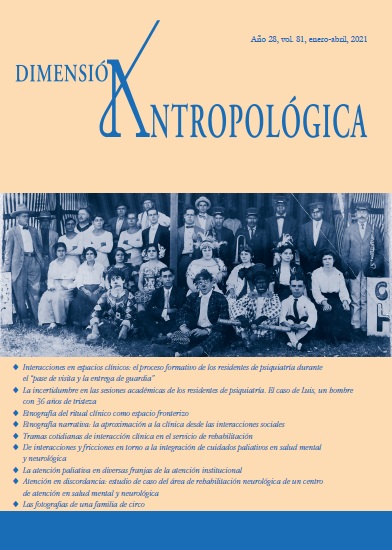Published 2021-04-30
Keywords
- Español
How to Cite
Abstract
To describe and analyze how narratives are produced in a clinical space, we developed an investigation in a third level healthcare hospital in the Metropolitan Area of Mexico´s Valley (Cifanep). We are guided by a socio-cultural frame of reference that enables the understanding of the narrative as structures that give an account of the self and the other in a co-production of meaning, thus demonstrating the importance of intersubjectivity. Articulated to this we appeal to the concept of strip of activity to make visible a sequence of events considered as an intersubjective, interpretive, and significant context that organizes the experience. With such coordinates my contribution in this work arouses from a reflexive and dialogical ethnography carried out in that strip of activity defined by the medical consultation. In this, routine behaviors constituted by norms, values and an asymmetry are reproduced that, in an institutional manner, expose in tension two different rationalities - doctor / patient. Ethnography highlights the narrative flow that articulates between observation, listening and field notes, the forms of interaction that reveal medical consultation as a clinical ritual and border space.
Downloads
References
- American Psychiatric Association, Diagnostic and Statistical Manual of Mental Disorders (DSM-5), 5a. ed., Washington DC, American Psychiatric Association Publishing, 2013.
- Atkinson, Paul y Lesley Pugsley, “Making Sense of Ethnography and Medical Education”, Medical Education, vol. 39, núm. 2, 2005, pp. 228-234.
- Benson, Peter y Arthur Kleinman, “Anthropology in the Clinic: The Problem of Cultural Competency and How to Fix it”, PLoS Medicine, vol. 3, núm. 10, 2006, pp. 1673-1676.
- Dikomitis, Lisa, “Reflections on Ethnography in Medicine”, The Cyprus Review, vol. 28, núm. 1, 2016, pp. 85-97.
- Goffman, Erwin, Frame Analysis: los marcos de la experiencia, Madrid, CIS, Siglo XXI, 2006.
- Hahn, Robert y Arthur Kleinman, “Biomedical Practice and Anthropological Theory”, Annual Review of Anthropology, vol. 12, 1983, pp. 305-333.
- Hunter, Cynthia, Debbi Long y Sjaak Van der Geest, “When the Field is a Ward or a Clinic: Hospital Ethnography”, Anthropology & Medicine, vol.15, 2008, pp. 71-78.
- Kleinman, Arthur, “Comments on the Cultural Context of Science and Scientific Creativity”, en Hans Krebs y Julian Henry Shelley (eds.), The Creative Process in Science and Medicine, Nueva York, American Elsevier, 1975.
- Lindenbaum, Shirley y Margaret M. Lock, Knowledge, Power and Practice: The Anthropology of Medicine and Everyday Life, Berkeley, University of California Press, 1993.
- Magister, Caveat, “(Re)Discovering Ritual’s Role in Medicine”, Burning Man Journal, 2017, recuperado de: [https://journal.burningman.org/2017/07/philosophical-center/the-theme/rediscovering-ritualsrole-in-medicine/].
- Mattingly, Cheryl, “In Search of the Good: Narrative Reasoning in Clinical Practice”, Medical Anthropology Quarterly, vol. 12, núm. 3, 1998a, pp. 273-297.
- ____________, Healing Dramas and Clinical Plots: The Narrative Structure of Experience, Cambridge, Cambridge University Press, 1998b.
- Ramírez Velázquez, Josefina, “Las emociones como categoría analítica en antropología. Un reto epistemológico, metodológico y personal”, en Oliva López y Rocío Enríquez (coords.), Cartografías emocionales. Las tramas de la teoría y la praxis, México, FES Iztacala-UNAM / ITESO (Colección Emociones e Interdisciplina), 2016, vol. II, pp. 97-126.
- ____________, “Algunas consideraciones sobre la narrativa como metodología idónea para el estudio del proceso salud/enfermedad/atención”, Revista CONAMED, año 21, vol. 2, México, 2016, pp. 66-70.
- ____________, “Una reflexión epistemológica para la construcción del cuerpo sentipensante: la búsqueda del cuerpo perdido”, Corpo Grafías. Estudios críticos de y desde los cuerpos, pp. 1-17. Aceptado para su publicación en julio 2019.
- Taussig, Michael, Un gigante en convulsiones. El mundo humano como sistema nervioso en emergencia permanente, Barcelona, Gedisa, 1995.
- Wind, Guitte, “Negotiated Interactive Observation: Doing Fieldwork in Hospital Settings”, Anthropology & Medicine, vol. 15, núm. 2, 2008, pp. 79-89. doi: 10.1080/13648470802127098.
- Young, Allan, “The Discourse on Stress and the Reproduction of Conventional Knowledge”, Social Science & Medicine. Part B: Medical Anthropology, vol. 14, núm. 3, 1980, pp. 133-146.
- ____________, “The Anthropology of Illness and Sickness”, Annual Review of Anthropology, vol. 11, Ohio, 1982, pp. 257-285.

